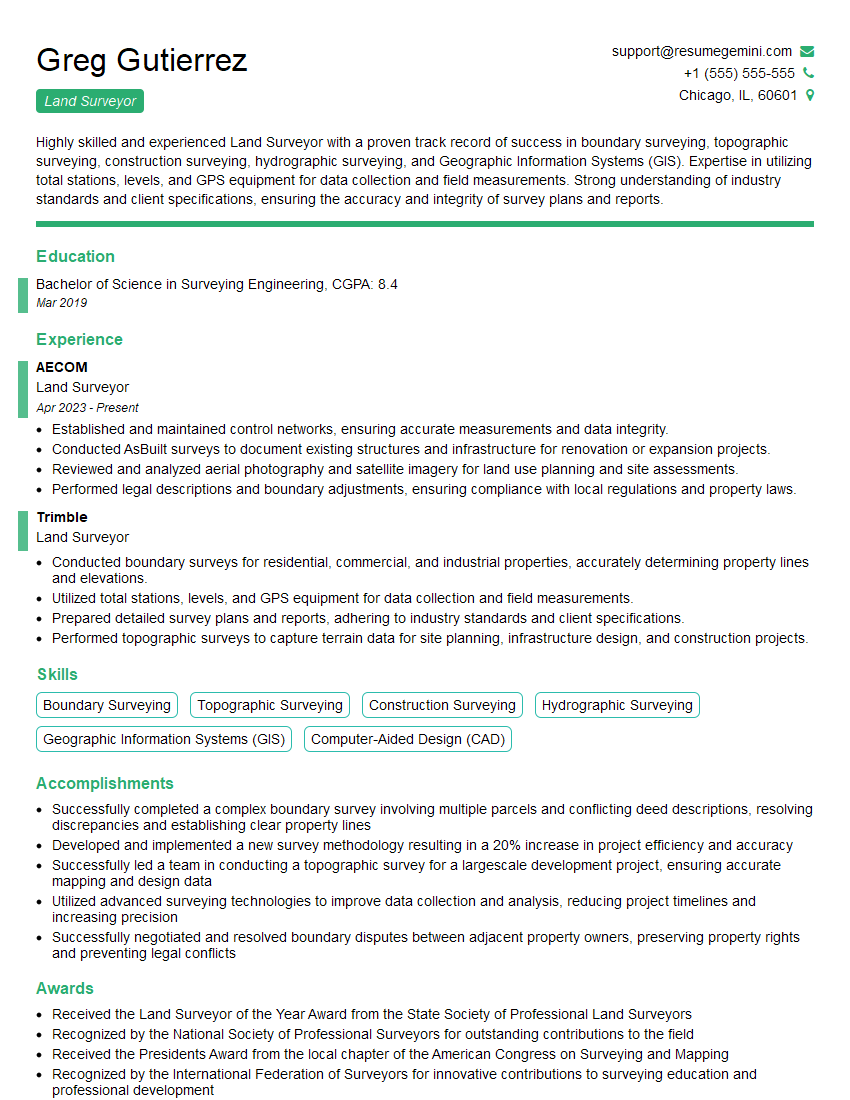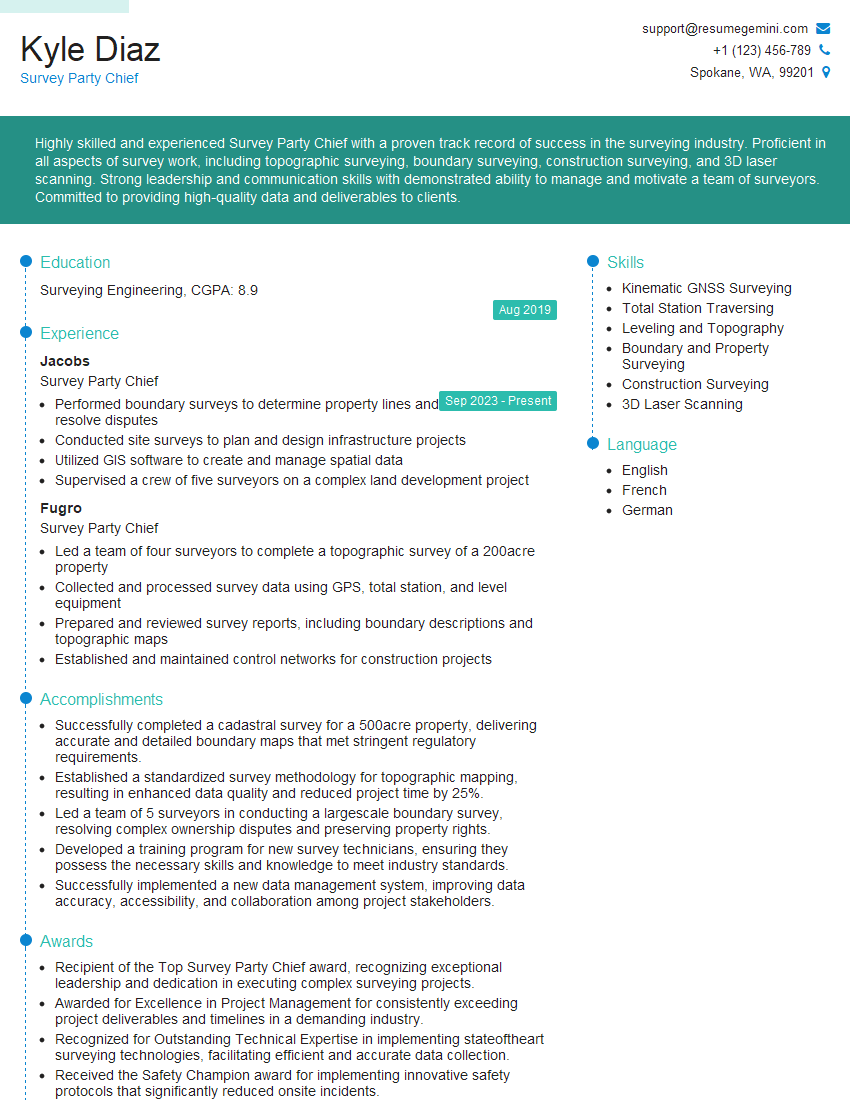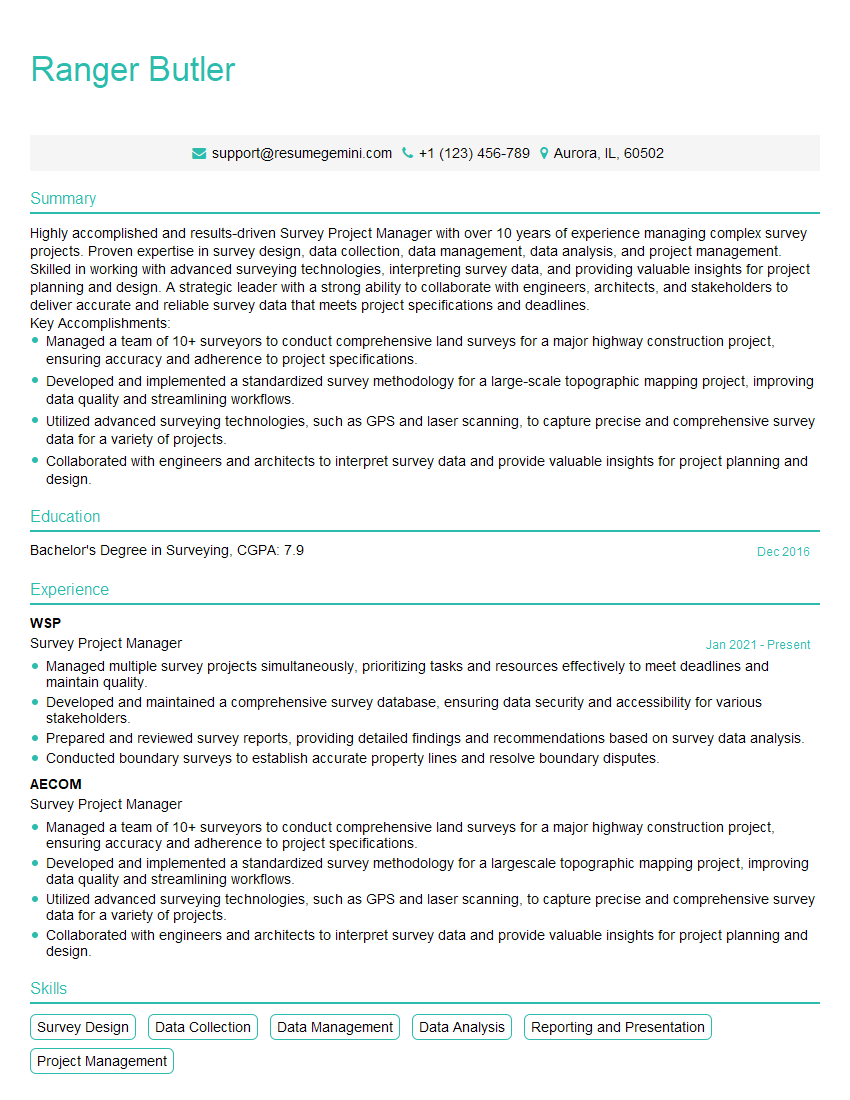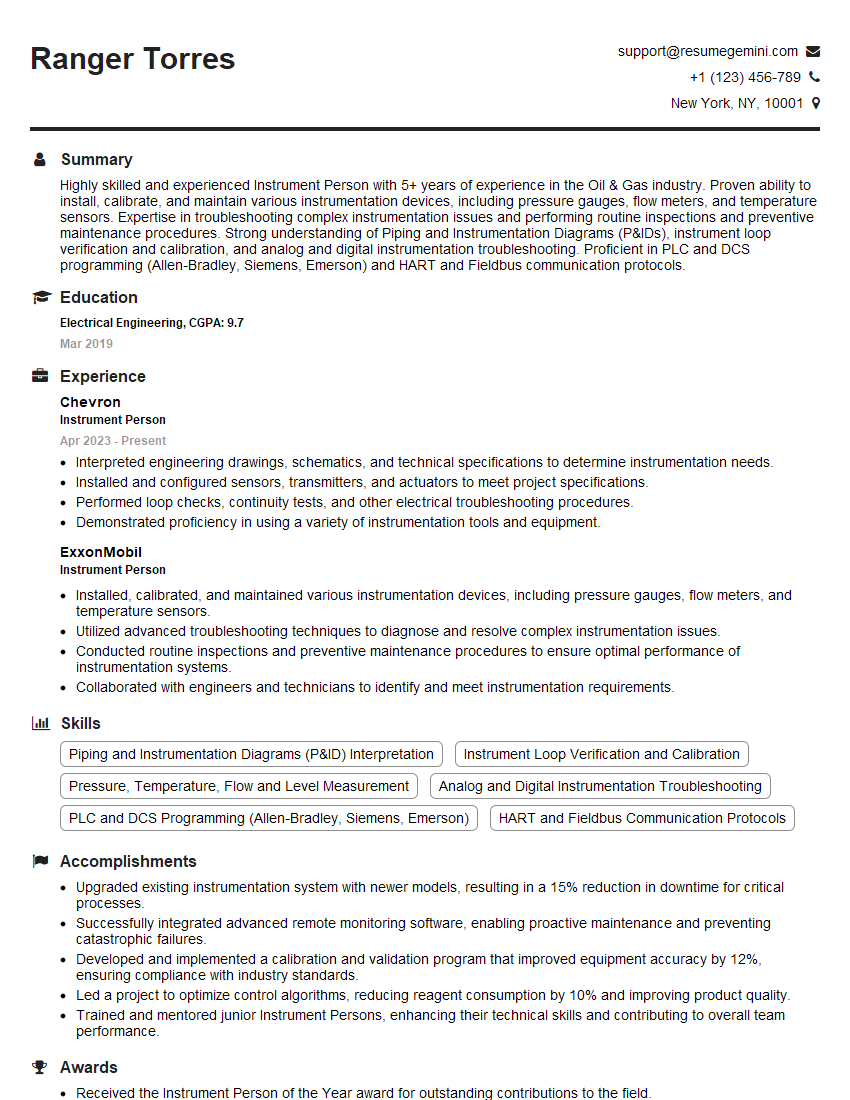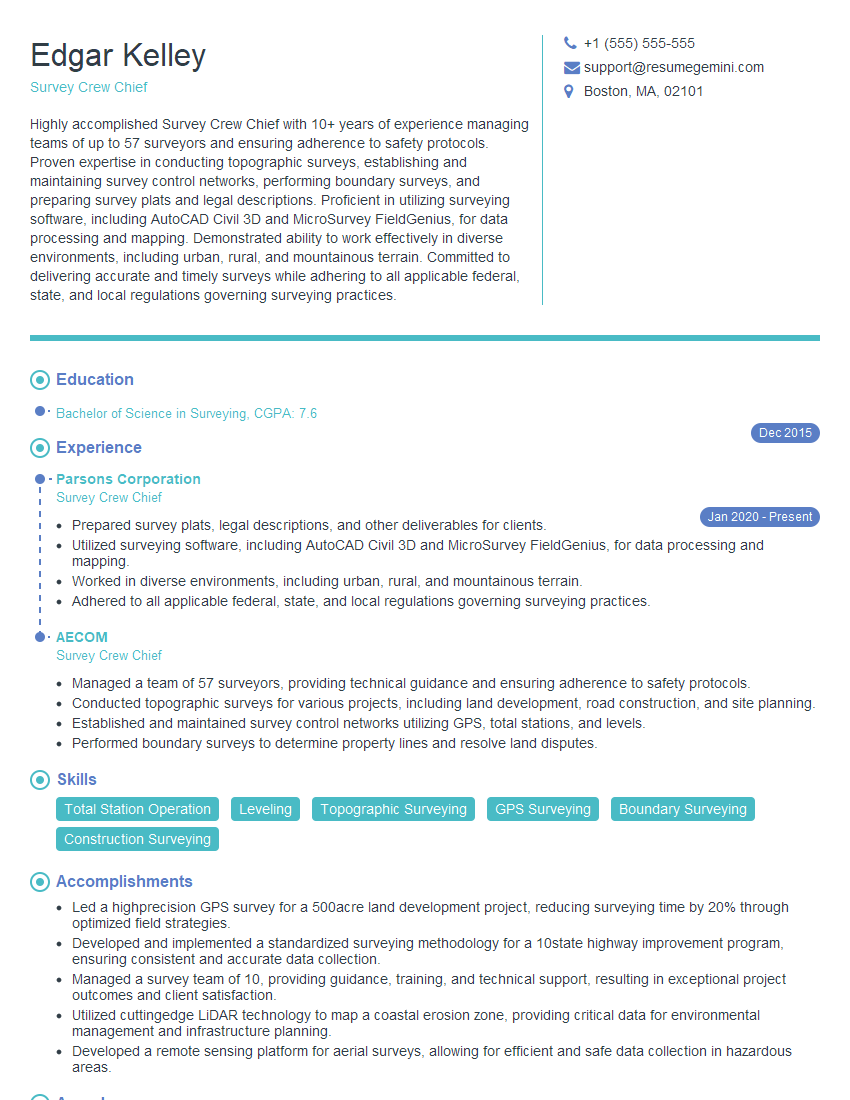Are you ready to stand out in your next interview? Understanding and preparing for Site Development Surveying interview questions is a game-changer. In this blog, we’ve compiled key questions and expert advice to help you showcase your skills with confidence and precision. Let’s get started on your journey to acing the interview.
Questions Asked in Site Development Surveying Interview
Q 1. Explain the different types of surveys used in site development.
Site development surveys encompass various types, each crucial for different project phases. They’re like a detailed medical checkup for a construction project, ensuring a healthy outcome.
- Boundary Surveys: These define the exact limits of a property, essential for legal compliance and planning. Imagine it as drawing the lines of ownership on the land.
- Topographic Surveys: These map the earth’s surface, showing elevation changes, contours, and natural and man-made features. Think of it as creating a detailed 3D model of the land’s surface.
- ALTA/NSPS Land Title Surveys: These combine elements of boundary and topographic surveys, providing comprehensive information for lenders and title companies, offering legal protection for all parties involved.
- Construction Surveys: These guide construction activities by accurately locating building lines, elevations, and other critical points. It’s like providing the blueprints for the construction crew to follow.
- As-Built Surveys: These document the final construction, verifying completion against the design and identifying any discrepancies. This is like a final inspection report, comparing the actual construction to the plan.
- Route Surveys: These are used for linear projects like roads and pipelines. They establish the alignment, grades, and cross-sections for these infrastructure projects.
Q 2. Describe your experience with GPS surveying equipment and software.
I have extensive experience with various GPS surveying equipment, including total stations (like Trimble and Leica), GNSS receivers (e.g., Topcon), and robotic total stations. My proficiency extends to software packages such as AutoCAD Civil 3D, ArcGIS, and specialized surveying software like Trimble Business Center and TerraSync. I’m comfortable processing raw GPS data, performing quality control checks, and generating accurate survey deliverables. For instance, I recently utilized a Trimble R10 GNSS receiver and Trimble Business Center to perform a high-accuracy boundary survey for a large commercial development, achieving centimeter-level accuracy despite challenging tree cover.
Q 3. How do you ensure accurate data collection in challenging field conditions?
Ensuring accurate data collection in challenging conditions requires a multi-pronged approach. It’s like navigating a maze, requiring careful planning and execution.
- Careful Planning: Thorough reconnaissance of the site to identify potential obstacles is crucial. This includes assessing vegetation, terrain, and potential interference.
- Redundancy: Employing multiple methods for data capture, such as combining GPS with traditional surveying techniques, provides checks and balances. Multiple measurements reduce error.
- Proper Equipment: Using appropriate equipment for the specific conditions is essential. For instance, using a total station with long-range capabilities in areas with poor visibility.
- Quality Control: Regularly checking instrument calibration, performing baseline measurements, and employing robust data processing techniques are paramount. Checking your work at every stage prevents compounding small mistakes.
- Environmental Considerations: Account for atmospheric conditions like temperature and pressure that can affect GPS measurements. Consider how temperature will impact your equipment.
Q 4. What are the common sources of error in surveying, and how do you mitigate them?
Common sources of error in surveying are numerous, ranging from instrument malfunction to human error. Identifying and mitigating these errors is crucial for accuracy.
- Instrumental Errors: These stem from faulty equipment, such as miscalibration of instruments or poor maintenance. Regular calibration and maintenance are key here.
- Natural Errors: These include atmospheric refraction (bending of light waves) and Earth curvature, impacting GPS signals. Employing atmospheric correction models and considering Earth curvature in calculations mitigates these errors.
- Personal Errors: Human errors are inevitable; these can be mistakes in reading instruments, recording data, or setting up equipment. Rigorous checks and double-checking of all data is vital.
- Systematic Errors: These are consistent and predictable errors, such as those caused by incorrect instrument setup or faulty leveling. Implementing proper procedures for setup and leveling minimizes these issues.
- Random Errors: These are unpredictable errors that fluctuate randomly. Statistical methods and multiple measurements help to reduce their impact.
Mitigation strategies involve employing proper surveying techniques, meticulous data recording, and rigorous quality control checks throughout the survey process.
Q 5. Explain your understanding of coordinate systems and datums.
Coordinate systems and datums are fundamental to surveying, providing the framework for locating points on the Earth’s surface. Think of it as the map’s grid and reference point.
Coordinate Systems: These define how points are located on a 2D or 3D surface. Common examples are UTM (Universal Transverse Mercator) and State Plane Coordinate Systems. UTM divides the Earth into zones, simplifying mapmaking.
Datums: These are reference surfaces that define the shape and size of the Earth. They provide a base for the coordinate system. Examples include NAD83 (North American Datum of 1983) and WGS84 (World Geodetic System of 1984). NAD83 is a North American datum used for most surveys in the US. Choosing the correct datum ensures compatibility and accuracy.
Understanding these is crucial for ensuring that survey data from different sources are compatible and correctly positioned relative to each other.
Q 6. How do you perform a boundary survey?
Performing a boundary survey is a meticulous process requiring legal expertise and precision. It’s akin to meticulously tracing the ownership lines of a property.
- Research: Begin with a thorough title search to understand the legal description of the property and identify any potential boundary disputes.
- Field Work: Locate existing monuments (markers) and evidence of the boundary, such as fences, old survey lines, and natural features. Employ advanced GPS equipment for precise measurements.
- Evidence Analysis: Analyze all collected evidence to determine the most likely location of the boundary. This may involve interpreting historical documents and reconciling conflicting evidence.
- Monumentation: Set new monuments or verify the existing ones to mark the boundary clearly. Proper monumentation is vital for long-term clarity.
- Plat Creation: Prepare a final boundary survey plat, showing the property boundaries, monuments, and other relevant information, adhering to standards and regulations.
This process ensures that the survey accurately reflects the legal boundaries of the property, protecting the owner’s interests.
Q 7. Describe your experience with topographic surveying.
Topographic surveying is the art of mapping the Earth’s surface, capturing its three-dimensional form. It’s like creating a detailed 3D model of the land.
My experience includes using various methods, including:
- Traditional Leveling: Using levels and leveling rods to determine elevations accurately over a defined area.
- Total Station Surveying: Employing total stations to measure distances, angles, and elevations efficiently.
- GPS Surveying: Utilizing GPS receivers for high-accuracy elevation measurements, especially over larger areas.
- Drone Surveying: Using drones with LiDAR or photogrammetry for quick and efficient data acquisition of large areas. This offers a bird’s eye view with unparalleled detail.
The data collected is used to create contour maps, cross-sections, and 3D models, providing essential information for site planning, engineering design, and construction management. For example, I recently used a combination of total station and drone surveying to generate a topographic survey for a large highway expansion project, accurately mapping the existing terrain and assisting engineers in optimizing the design.
Q 8. How do you interpret survey plans and drawings?
Interpreting survey plans and drawings involves understanding the symbology, scales, and conventions used to represent the real-world features on paper or digitally. It’s like reading a map, but with much more detail and precision.
Firstly, I carefully examine the title block to understand the project details, date of survey, and the surveyor’s information. Next, I identify the different symbols representing features like buildings, trees, roads, and property boundaries. The scale is crucial – it tells me the ratio between the drawing and real-world dimensions. I check the north arrow for orientation. I look for contour lines to understand the topography of the land, and spot levels for precise elevations.
For example, a circle with a cross might represent a survey benchmark, a dashed line might represent a property boundary, and contour lines close together indicate a steep slope. Understanding these conventions is paramount. I also cross-reference information, checking that all elements, including spot heights and property lines, align logically and are consistent with the accompanying data.
Q 9. What is your experience with legal descriptions and property lines?
My experience with legal descriptions and property lines is extensive. I’m proficient in interpreting various legal descriptions, including metes and bounds descriptions (which use bearings and distances to define boundaries), and descriptions based on recorded plats or government surveys. This involves understanding the terminology, accurately identifying monuments (physical markers defining property corners), and tracing property boundaries on the ground and on plans.
I’ve encountered numerous instances where subtle inaccuracies in legal descriptions have needed clarification or correction through research of deeds, title reports, and historical records. For instance, a recent project involved a metes and bounds description with a vague reference point. By consulting historical maps and conducting a field survey, I successfully identified the correct starting point, preventing a potential boundary dispute.
Q 10. Explain the process of setting out construction points.
Setting out construction points is a crucial phase in site development, ensuring the building or infrastructure is constructed precisely according to the design. It begins with transferring the design coordinates from the survey plan onto the site. This involves using accurate surveying equipment like total stations, GPS receivers, or even traditional methods like tapes and theodolites, depending on the project’s scale and complexity.
The process typically starts with establishing a control network on site – a series of accurately positioned points that serve as a reference. From these control points, we use the coordinates from the design plans to calculate and set out individual construction points, such as corner points of a building, column locations, or pipeline alignments. We use rigorous quality control measures, including double checking measurements and using independent methods to verify our work. For example, we might use both total station and GPS measurements to cross-check the position of a critical point.
Q 11. How do you handle discrepancies between survey data and design plans?
Discrepancies between survey data and design plans are common and require careful handling to avoid costly errors. The first step is to meticulously compare the two datasets, identifying the nature and extent of the differences. This often involves overlaying the survey data onto the design plans using surveying software.
The reasons for discrepancies can range from errors in the original survey to design revisions made after the initial survey. Once identified, the cause needs investigation. Minor discrepancies might be accommodated through minor adjustments in the construction process; however, significant discrepancies require a collaborative approach with the design team. Options include revising the design to fit the site conditions, or revisiting the survey to confirm or correct the data. In all cases, thorough documentation of the discrepancies and resolution is essential.
Q 12. Describe your proficiency with surveying software (e.g., AutoCAD Civil 3D, Revit).
I’m proficient in several surveying software packages, including AutoCAD Civil 3D and Revit. I use AutoCAD Civil 3D extensively for tasks such as creating surface models from survey data, designing roads and drainage systems, and generating construction plans. I’m also experienced with the use of Revit for coordinating the survey data with building information models (BIM). This allows for better integration and collision detection between different disciplines involved in the project.
For example, I have utilized AutoCAD Civil 3D to create a 3D model of a large-scale highway project, incorporating survey data from multiple sources. This enabled efficient earthworks calculation and accurate design of road alignments and drainage structures. My experience with Revit extends to integrating survey data with building models to ensure accurate positioning of the building in relation to site features.
Q 13. Explain your experience with volumetric calculations.
Volumetric calculations are frequently needed in site development, particularly for earthworks. This involves calculating the volume of earth to be excavated or filled. I use various methods, including the cross-sectional method (measuring areas at intervals along the length), the contour method (using contour lines to estimate volumes), and 3D modelling techniques (utilizing software like Civil 3D to generate precise volume calculations).
For instance, on a recent project, we used the cross-sectional method to calculate the volume of earth needed for a large-scale excavation. We surveyed the site at regular intervals and used the data to create cross-sections in Civil 3D, which automatically calculated the volume. Accurate volumetric calculations are crucial for cost estimation, material procurement, and efficient site management.
Q 14. How do you ensure the safety of your crew during fieldwork?
Safety is paramount in all aspects of my work. Before commencing any fieldwork, I conduct a thorough site risk assessment, identifying potential hazards such as traffic, uneven terrain, underground utilities, and weather conditions. I develop and implement a site-specific safety plan that includes clear procedures for working near traffic, using personal protective equipment (PPE), and communicating with team members.
This includes regular toolbox talks to reinforce safety procedures and address any concerns. We utilize appropriate safety equipment, including high-visibility clothing, hard hats, safety boots, and fall protection equipment where necessary. We adhere strictly to all relevant safety regulations and guidelines and maintain comprehensive records of our safety procedures and any incidents that may occur. A proactive and preventative approach to safety ensures a secure working environment for my crew and minimizes risk.
Q 15. Describe your experience with different surveying instruments (e.g., total stations, levels).
My experience with surveying instruments is extensive, encompassing both traditional and modern technologies. I’m proficient in using total stations, which are highly accurate electronic instruments used for measuring distances, angles, and coordinates. Think of them as incredibly precise 3D rulers and protractors combined. I’ve used them extensively for setting out building foundations, creating topographic surveys for large-scale projects, and performing precise control surveys.
Furthermore, I’m highly skilled with automatic levels, used for determining elevations and creating level lines. These are crucial for establishing benchmarks and creating contour maps, essential for drainage planning and earthworks. I’ve used these on projects ranging from small residential sites to large-scale infrastructure development. My experience also includes the use of GNSS (Global Navigation Satellite System) receivers, like GPS units, for more rapid surveying, especially over large areas, though I always carefully consider the limitations of precision and potential sources of error with this technology.
Beyond these core instruments, I’m comfortable using other equipment like digital theodolites, EDM (electronic distance measurement) devices, and robotic total stations, ensuring I can select the best tool for the job, depending on the project’s size, complexity, and accuracy requirements.
Career Expert Tips:
- Ace those interviews! Prepare effectively by reviewing the Top 50 Most Common Interview Questions on ResumeGemini.
- Navigate your job search with confidence! Explore a wide range of Career Tips on ResumeGemini. Learn about common challenges and recommendations to overcome them.
- Craft the perfect resume! Master the Art of Resume Writing with ResumeGemini’s guide. Showcase your unique qualifications and achievements effectively.
- Don’t miss out on holiday savings! Build your dream resume with ResumeGemini’s ATS optimized templates.
Q 16. How do you manage large datasets and ensure data integrity?
Managing large datasets and ensuring data integrity is paramount in surveying. I utilize a multi-faceted approach involving robust data management software, rigorous quality control procedures, and a systematic workflow. I typically use industry-standard software packages that allow for efficient data processing, storage, and analysis. This includes software capable of handling various file formats (like DXF, LandXML) and providing features for data checking and error detection.
Data integrity is maintained through several key strategies: Regular backups are implemented, redundancy is built into data storage, and rigorous quality checks are performed at each stage of the process – from data collection to final report generation. This often involves employing techniques like least squares adjustment to resolve discrepancies and improve the overall accuracy of the survey data. Any anomalies are investigated thoroughly, with detailed records kept of all adjustments and corrections made. Furthermore, I always ensure that appropriate metadata is attached to all datasets, providing context and traceability for future use and audits.
For example, on a recent large-scale highway project, we used a cloud-based data management system to share and manage the extensive dataset among multiple teams. This allowed for real-time collaboration and ensured everyone worked with the most up-to-date information while maintaining strict version control and access permissions.
Q 17. What is your experience with using various types of leveling equipment?
My experience with leveling equipment is broad, encompassing various types including automatic levels, digital levels, and even traditional dumpy levels. I understand the principles behind each type and their respective strengths and weaknesses. Automatic levels are my go-to for most projects due to their speed and efficiency. They automate the leveling process, reducing the time required for setup and measurement. However, I understand their limitations regarding accuracy and environmental factors (like strong winds) and account for them in the survey planning.
Digital levels offer further advantages, providing digital readings that can be directly transferred to software for processing. This reduces errors associated with manual data entry. While I appreciate the convenience of modern digital systems, I also recognize the importance of understanding the fundamentals of traditional leveling techniques using dumpy levels, as this allows for better troubleshooting and problem-solving in the field. I can quickly identify potential issues and implement solutions even with more basic instruments. Choosing the right equipment always depends on the project’s demands and budget.
Q 18. Explain your understanding of different types of survey control.
Survey control refers to the network of precisely located points that form the framework for all other measurements. There are several types. Geodetic control involves establishing points with high accuracy, usually using GNSS and precise leveling, often tied to national or international geodetic datums. These are typically used for large-scale projects and map making. State Plane Coordinate System (SPCS) points, for instance, are a common type of geodetic control.
Local control, in contrast, establishes a network of points within a smaller area, using techniques like traversing (measuring angles and distances) or triangulation. This is often sufficient for smaller construction projects. Control points established via GPS differencing methods provide another important framework, offering a flexible and cost-effective approach, particularly in areas with limited visibility.
Understanding different control types is essential for selecting the appropriate strategy for each survey. The choice depends on the project’s size, required accuracy, and existing control available. Proper control planning ensures that all subsequent measurements are accurately positioned and tied to a known reference system.
Q 19. How do you deal with unexpected challenges or delays during a survey project?
Unexpected challenges are part and parcel of site development surveying. My approach involves proactive planning and a flexible mindset. This includes thorough site reconnaissance to anticipate potential issues, like obstructed views or difficult terrain. However, unexpected problems do arise. I have encountered everything from unforeseen underground utilities to weather delays.
My response always emphasizes communication and problem-solving. Open communication with the client and project team is crucial to manage expectations and find solutions. For example, when unexpected underground utilities were discovered on a recent project, we immediately communicated the finding to the client and coordinated with utility companies to resolve the issue safely and efficiently, which involved adjusting the survey plan and re-scheduling some tasks. I’m adept at adapting my methods and implementing alternative strategies to overcome unforeseen obstacles, minimizing project delays and maintaining accuracy and safety.
Q 20. Describe your experience with preparing survey reports and deliverables.
Preparing clear and comprehensive survey reports and deliverables is crucial for successful projects. My reports are structured to provide a concise yet detailed overview of the survey findings. They typically include a project overview, methodology description, data tables, maps, drawings (like contour maps, cross-sections, and location plans), and an analysis of results. All data is presented in a clear and easy-to-understand format, often complemented by visual aids like diagrams and photographs to enhance understanding.
I’m proficient in using various software packages to create high-quality reports and drawings, ensuring they conform to industry standards and client requirements. For instance, I’ve used AutoCAD Civil 3D to create detailed site plans and 3D models and have produced reports using Microsoft Word and Excel. I believe in tailoring the level of detail in my reports to match the client’s needs and technical background, ensuring the information is readily accessible and easily interpreted.
Q 21. Explain the importance of quality control in surveying.
Quality control (QC) is fundamental to ensuring the accuracy, reliability, and integrity of survey data. It’s a systematic process that involves implementing checks and procedures at every stage of the project. This begins with checking equipment calibration before fieldwork, through to verifying data consistency during processing and reviewing final deliverables before submission.
QC procedures include regular instrument checks, independent measurements, cross-checking of data, and rigorous error analysis. For example, I might use redundant measurements to check the consistency of results. This ensures the accuracy of our measurements and also helps identify and resolve any inconsistencies or errors early on. It also involves strict adherence to established standards and best practices, using appropriate techniques for error propagation and adjustment. This meticulous approach minimizes errors and ensures that the final survey results meet the required accuracy standards. Ignoring QC can lead to costly mistakes down the line, so it’s always a priority.
Q 22. What is your experience working with clients and stakeholders?
Throughout my career, I’ve collaborated extensively with clients and stakeholders from diverse backgrounds, including architects, engineers, developers, and property owners. Effective communication is paramount. I begin by actively listening to understand their needs and project goals, ensuring a clear understanding of the scope and expectations. This includes carefully reviewing project briefs, attending site meetings, and providing regular updates on progress, potential challenges, and solutions. For instance, on a recent high-rise development, I worked closely with the structural engineer to ensure that my survey data accurately reflected the complexities of the site’s topography, preventing costly revisions later in the construction process. I also find it invaluable to present information visually – using maps, 3D models, and clear reports – to enhance comprehension and facilitate informed decision-making. I believe in fostering transparent relationships built on trust and mutual respect, always prioritizing client satisfaction and project success.
Q 23. How do you stay current with advancements in surveying technology?
The surveying field is constantly evolving, so continuous professional development is crucial. I actively participate in industry conferences, webinars, and workshops to stay abreast of the latest technologies and techniques. I am a member of several professional surveying organizations which offer valuable resources and training. I also subscribe to industry publications and regularly review technical journals. Furthermore, I actively seek out and experiment with new software and hardware solutions, such as drone-based surveying techniques and advanced GPS systems. For example, I recently completed training on using LiDAR technology, which greatly enhanced my ability to create highly accurate and detailed topographic models, significantly improving the efficiency of my data acquisition processes.
Q 24. Describe your understanding of relevant safety regulations and standards.
Safety is my utmost priority. I am fully compliant with all relevant occupational health and safety regulations and standards, including those set by OSHA (Occupational Safety and Health Administration) and relevant state/local agencies. This includes rigorous adherence to safe working practices, the correct use of personal protective equipment (PPE), such as hard hats, high-visibility clothing, and safety boots, and risk assessments before undertaking any fieldwork. I ensure that all my team members are properly trained and equipped to work safely. Before starting any project, we conduct a thorough site safety analysis, identifying and mitigating potential hazards such as uneven terrain, traffic risks, and underground utilities. Regular safety briefings are part of our standard operating procedure. We meticulously document all safety procedures and incident reports to maintain a safe and productive work environment. Our commitment to safety is not just a policy but a core value.
Q 25. How do you calculate horizontal and vertical distances?
Calculating horizontal and vertical distances is fundamental to surveying. Horizontal distances are typically measured using total stations or GPS systems. Total stations measure angles and distances electronically, and these measurements are then used with trigonometry (e.g., cosine rule) to calculate the horizontal distance. GPS systems use satellite signals to determine the coordinates of points, and the horizontal distance between points is then calculated using coordinate geometry. Vertical distances (differences in elevation) are calculated using leveling techniques. This involves using a level instrument and leveling rods to establish a series of benchmark points with known elevations. The difference in elevation between two points is then obtained by taking the difference in their respective readings. For instance, if one point reads 1.5m and another 2.8m on the levelling rod, the difference in elevation is 1.3m. More complex calculations might involve using trigonometric functions and considering the effects of curvature and refraction when dealing with longer distances.
Q 26. Explain the difference between precision and accuracy in surveying.
Precision and accuracy are often confused, but they represent distinct concepts in surveying. Accuracy refers to how close a measured value is to the true value. It reflects the overall quality and reliability of the measurement process, considering both systematic and random errors. Precision, on the other hand, refers to how closely repeated measurements agree with each other. High precision indicates that repeated measurements are clustered closely together, but this doesn’t guarantee accuracy. For example, a poorly calibrated instrument might consistently give readings that are clustered tightly (high precision), but all significantly offset from the true value (low accuracy). A successful survey requires both high precision and high accuracy, achieved through careful instrument calibration, meticulous field procedures, and appropriate data processing techniques.
Q 27. Describe your experience with utilizing BIM (Building Information Modeling) in surveying.
I have significant experience integrating Building Information Modeling (BIM) into my surveying workflow. BIM allows for the creation of a digital representation of a building or infrastructure project. In surveying, this integration enhances efficiency and accuracy. I utilize BIM software to import survey data, such as point clouds and digital terrain models, creating highly detailed and accurate 3D models. This allows for clash detection between different disciplines (e.g., architectural, structural, MEP), facilitating early problem identification and resolution. Furthermore, I use BIM to generate precise as-built models that are incredibly useful for construction management and facility maintenance. For example, on a recent hospital renovation project, the integration of my survey data into the BIM model facilitated a streamlined workflow, and the identification of potential clashes before construction commenced, thus minimizing costly rework and delays.
Q 28. How do you communicate technical information effectively to non-technical audiences?
Communicating complex technical information to non-technical audiences requires clear, concise, and relatable language. I avoid using jargon and technical terms unless absolutely necessary, and when I do, I explain them clearly. I rely heavily on visual aids like maps, diagrams, and 3D models to convey information effectively. I also employ analogies and real-world examples to make abstract concepts more understandable. For instance, instead of saying “the site has a significant grade variation,” I might explain “the land slopes steeply in this area, much like a hillside.” I frequently summarize key findings in plain English, ensuring that all stakeholders, regardless of their technical background, can comprehend the information and make informed decisions based on it. Active listening and careful attention to the audience’s understanding are key to ensuring effective communication. I regularly ask for clarification and confirmation that the information is being understood.
Key Topics to Learn for Site Development Surveying Interview
- Legal and Regulatory Frameworks: Understanding relevant building codes, zoning regulations, and environmental laws impacting site development.
- Topographic Surveys and Data Analysis: Interpreting contour lines, creating elevation models, and analyzing data for site grading and drainage planning. Practical application: Determining optimal building placement based on slope and soil conditions.
- Boundary Surveys and Property Line Determination: Accurately defining property limits using legal descriptions and field measurements. Practical application: Preventing boundary disputes and ensuring accurate site layout.
- Site Planning and Design: Collaborating with engineers and architects to integrate survey data into site plans, including utilities, roadways, and landscaping. Practical application: Optimizing site layout for functionality and aesthetics.
- Construction Surveying: Monitoring construction progress, ensuring adherence to plans and specifications, and performing as-built surveys. Practical application: Preventing costly errors and delays during construction.
- GPS and Surveying Technology: Proficiency in using GPS equipment, total stations, and related software for data collection and processing. Practical application: Improving efficiency and accuracy of surveys.
- Volume Calculations and Earthwork Estimation: Accurately determining cut and fill volumes for earthmoving operations. Practical application: Optimizing earthwork costs and minimizing environmental impact.
- Data Analysis and Reporting: Presenting survey data clearly and concisely through reports and maps, using appropriate software and communication techniques.
- Problem-solving and Critical Thinking: Analyzing complex site conditions, identifying potential challenges, and developing effective solutions.
Next Steps
Mastering Site Development Surveying is crucial for a rewarding and successful career in the construction and engineering industries. Proficiency in this field opens doors to diverse roles with excellent growth potential. To maximize your job prospects, it’s essential to create a resume that highlights your skills and experience effectively and is optimized for Applicant Tracking Systems (ATS). We strongly encourage you to leverage ResumeGemini, a trusted resource, to build a professional and impactful resume. ResumeGemini offers examples of resumes tailored specifically to Site Development Surveying, providing you with a head start in creating a compelling application that stands out from the competition.
Explore more articles
Users Rating of Our Blogs
Share Your Experience
We value your feedback! Please rate our content and share your thoughts (optional).
What Readers Say About Our Blog
Hello,
We found issues with your domain’s email setup that may be sending your messages to spam or blocking them completely. InboxShield Mini shows you how to fix it in minutes — no tech skills required.
Scan your domain now for details: https://inboxshield-mini.com/
— Adam @ InboxShield Mini
Reply STOP to unsubscribe
Hi, are you owner of interviewgemini.com? What if I told you I could help you find extra time in your schedule, reconnect with leads you didn’t even realize you missed, and bring in more “I want to work with you” conversations, without increasing your ad spend or hiring a full-time employee?
All with a flexible, budget-friendly service that could easily pay for itself. Sounds good?
Would it be nice to jump on a quick 10-minute call so I can show you exactly how we make this work?
Best,
Hapei
Marketing Director
Hey, I know you’re the owner of interviewgemini.com. I’ll be quick.
Fundraising for your business is tough and time-consuming. We make it easier by guaranteeing two private investor meetings each month, for six months. No demos, no pitch events – just direct introductions to active investors matched to your startup.
If youR17;re raising, this could help you build real momentum. Want me to send more info?
Hi, I represent an SEO company that specialises in getting you AI citations and higher rankings on Google. I’d like to offer you a 100% free SEO audit for your website. Would you be interested?
Hi, I represent an SEO company that specialises in getting you AI citations and higher rankings on Google. I’d like to offer you a 100% free SEO audit for your website. Would you be interested?
good
